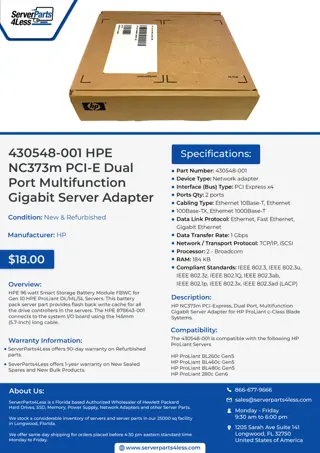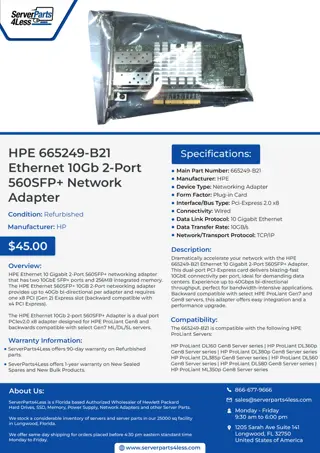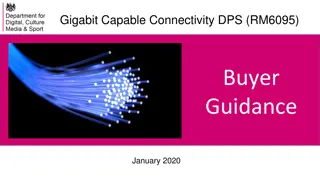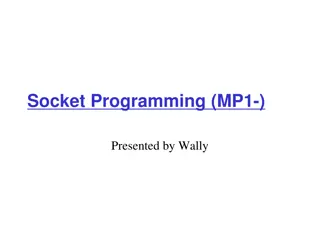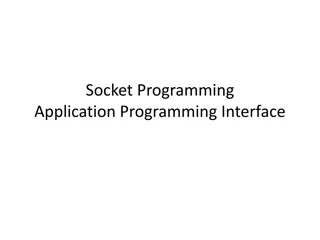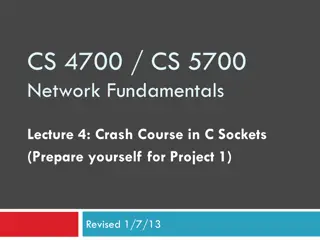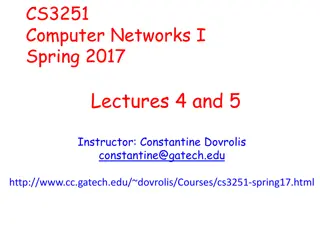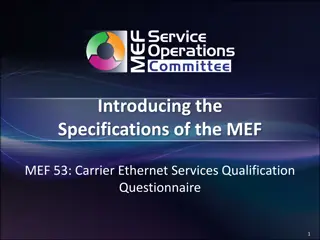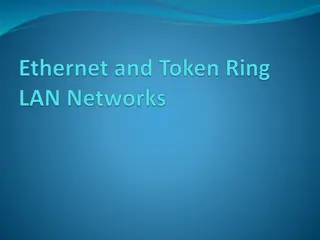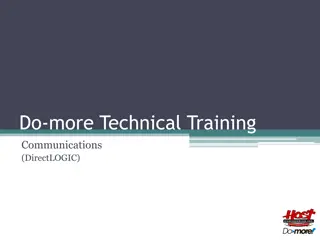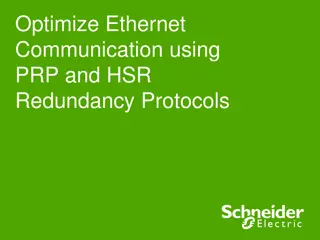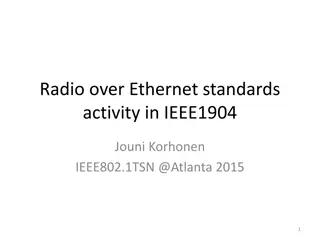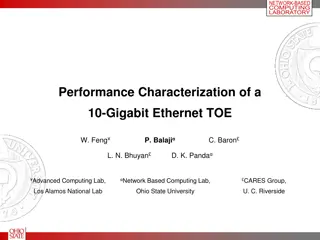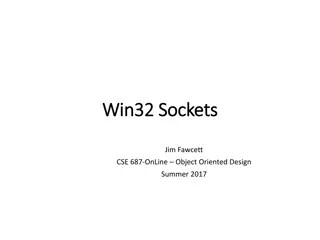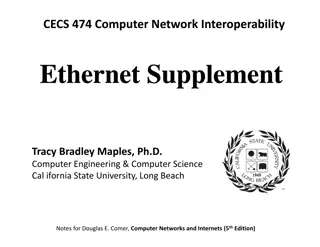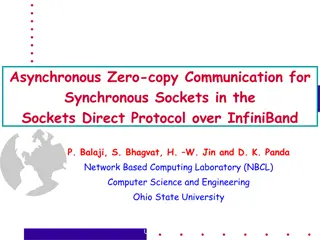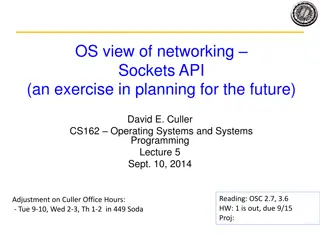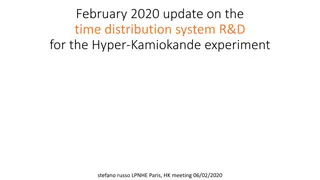High Performance User-Level Sockets over Gigabit Ethernet
Presentation overview of the design challenges, performance enhancement techniques, and results related to implementing high-performance user-level sockets over Gigabit Ethernet networks. The background and motivation discuss the limitations of traditional kernel-based implementations and the need for user-level support. Alternative implementations and protocols like EMP are explored for achieving high performance in socket communication. The content also delves into the advantages and drawbacks of different approaches, offering insights into the development of efficient networking protocols.
Download Presentation

Please find below an Image/Link to download the presentation.
The content on the website is provided AS IS for your information and personal use only. It may not be sold, licensed, or shared on other websites without obtaining consent from the author.If you encounter any issues during the download, it is possible that the publisher has removed the file from their server.
You are allowed to download the files provided on this website for personal or commercial use, subject to the condition that they are used lawfully. All files are the property of their respective owners.
The content on the website is provided AS IS for your information and personal use only. It may not be sold, licensed, or shared on other websites without obtaining consent from the author.
E N D
Presentation Transcript
High Performance User-Level Sockets over Gigabit Ethernet Pavan Balaji Ohio State University balaji@cis.ohio-state.edu Piyush Shivam Ohio State University shivam@cis.ohio-state.edu Pete Wyckoff D.K. Panda Ohio State University panda@cis.ohio-state.edu Ohio Supercomputer Center pw@osc.edu
Presentation Overview Background and Motivation Design Challenges Performance Enhancement Techniques Performance Results Conclusions
Background and Motivation Sockets Frequently used API Traditional Kernel-Based Implementation Unable to exploit High Performance Networks Earlier Solutions Interrupt Coalescing Checksum Offload Insufficient It gets worse with 10 Gigabit Networks Can we do better User-level support
Kernel Based Implementation of Sockets User Space Pros Application or Library High Compatibility Cons Sockets Kernel Context Switches TCP Kernel Multiple Copies CPU Resources IP NIC Hardware
Alternative Implementations of Sockets (GigaNet cLAN) User Space Pros Application or Library High Compatibility Cons Sockets Kernel Context Switches TCP Kernel Multiple Copies CPU Resources IP IP-to-VI layer Hardware VI aware NIC
Sockets over User-Level Protocols Sockets is a generalized protocol Sockets over VIA Developed by Intel Corporation [shah98] and ET Research Institute [sovia01] GigaNet cLAN platform Most networks in the world are Ethernet Gigabit Ethernet Backward compatible Gigabit Network over the existing installation base MVIA: Version of VIA on Gigabit Ethernet Kernel Based A need for a High Performance Sockets layer over Gigabit Ethernet
User-Level Protocol over Gigabit Ethernet Ethernet Message Passing (EMP) Protocol Zero-Copy OS-Bypass NIC-driven User-Level protocol over Gigabit Ethernet Developed over the Dual-processor Alteon NICs Complete Offload of message passing functionality to the NIC Piyush Shivam, Pete Wyckoff, D.K. Panda, EMP: Zero-Copy OS-bypass NIC- driven Gigabit Ethernet Message Passing , Supercomputing, November 01 Piyush Shivam, Pete Wyckoff, D.K. Panda, Can User-Level Protocols take advantage of Multi-CPU NICs? , IPDPS, April 02
EMP: Latency 250 200 Latency (us) 150 TCP EMP 100 50 0 4 8 16 32 64 128 256 512 1K 2K 4K Message Size (bytes) A base latency of 28 s compared to an ~120 s of TCP for 4-byte messages
EMP: Bandwidth 1200 1000 Bandwidth (Mbps) 800 EMP TCP 600 400 200 0 4 8 16 32 64 128 256 512 1K 2K 4K 8K Message Size (bytes) Saturated the Gigabit Ethernet network with a peak bandwidth of 964Mbps
Proposed Solution Application or Library Kernel Context Switches Multiple Copies Sockets over EMP User Space CPU Resources High Performance EMP Library OS Agent Kernel Gigabit Ethernet NIC Hardware
Presentation Overview Background and Motivation Design Challenges Performance Enhancement Techniques Performance Results Conclusions
Design Challenges Functionality Mismatches Connection Management Message Passing Resource Management UNIX Sockets
Functionality Mismatches and Connection Management Functionality Mismatches No API for buffer advertising in TCP Connection Management Data Message Exchange Descriptors required for connection management
Message Passing Message Passing Data Streaming Parts of the same message can be read potentially to different buffers Unexpected Message Arrivals Separate Communication Thread Keeps track of used descriptors and re-posts Polling Threads have high Synchronization cost Sleeping Threads involve OS scheduling granularity Rendezvous Approach Eager with Flow Control
Rendezvous Approach Sender SQ Receiver SQ RQ RQ send() Request receive() ACK Data
Eager with Flow Control Sender SQ Receiver SQ RQ RQ send() Data receive() ACK Data
Resource Management and UNIX Sockets Resource Management Clean up unused descriptors (connection management) Free registered memory UNIX Sockets Function Overriding Application Changes File Descriptor Tracking
Presentation Overview Background and Motivation Design Challenges Performance Enhancement Techniques Performance Results Conclusions
Performance Enhancement Techniques Credit Based Flow Control Disabling Data Streaming Delayed Acknowledgments EMP Unexpected Queue
Credit Based Flow Control Multiple Outstanding Credits Sender SQ Receiver SQ RQ RQ Credits Left: 4 Credits Left: 3 Credits Left: 2 Credits Left: 1 Credits Left: 0 Credits Left: 4
Non-Data Streaming and Delayed Acknowledgments Disabling Data Streaming Intermediate copy required for Data Streaming Place data directly into user buffer Delayed Acknowledgments Increase in Bandwidth Lesser Network Traffic NIC has lesser work to do Decrease in Latency Lesser descriptors posted Lesser Tag Matching at the NIC 550ns per descriptor
EMP Unexpected Queue EMP Unexpected Queue EMP features unexpected message queue Advantages: Last to be checked Disadvantage: Data Copy Acknowledgments in the Unexpected Queue No copy, since acknowledgments carry no data Acknowledgments pushed out of the critical path
Presentation Overview Background and Motivation Design Challenges Performance Enhancement Techniques Performance Results Conclusions
Performance Results Micro-benchmarks Latency (ping-pong) Bandwidth FTP Application Web Server HTTP/1.0 Specifications HTTP/1.1 Specifications
Experimental Test-bed Four Pentium III 700Mhz Quads 1GB Main Memory Alteon NICs Packet Engine Switch Linux version 2.4.18
Micro-benchmarks: Latency 250 200 Latency (us) TCP Data Streaming Non-Data Streaming EMP 150 100 50 0 4 16 64 256 1K 4K Message Size (bytes) Up to 4 times improvement compared to TCP Overhead of 0.5us compared to EMP
Micro-benchmarks: Bandwidth 900 800 Bandwidth (Mbps) 700 600 Data Streaming Non-Data Streaming TCP Enhanced TCP 500 400 300 200 100 0 4 8 16 32 64 128 256 512 1K 2K 4K 8K 16K 32K 64K 128 Message Size (bytes) An improvement of 53% compared to enhanced TCP
FTP Application 12 10 Transfer Time (secs) 8 6 Data Streaming Non-Data Streaming TCP 4 2 0 1 4 16 64 256 File Size (Mbytes) Up to 2 times improvement compared to TCP
Web Server (HTTP/1.0) 12000 Transactions per second 10000 8000 TCP Data Streaming Non-Data Streaming 6000 4000 2000 0 4 16 64 256 1K 4K Response Size (bytes) Up to 6 times improvement compared to TCP
Web Server (HTTP/1.1) 18000 Transactions per second 16000 14000 12000 TCP Data Streaming Non-Data Streaming 10000 8000 6000 4000 2000 0 4 16 64 256 1K 4K Response Size (bytes) Up to 3 times improvement compared to TCP
Conclusions Developed a High Performance User-Level Sockets implementation over Gigabit Ethernet Latency close to base EMP (28 s) 28.5 s for Non-Data Streaming 37 s for Data Streaming sockets 4 times improvement in latency compared to TCP Peak Bandwidth of 840Mbps 550Mbps obtained by TCP with increased Registered space for the kernel (up to 2MB) Default case is 340Mbps with 32KB Improvement of 53%
Conclusions (contd.) FTP Application shows an improvement of nearly 2 times Web Server shows tremendous performance improvement HTTP/1.0 shows an improvement of up to 6 times HTTP/1.1 shows an improvement of up to 3 times
Future Work Dynamic Credit Allocation NIC: The trusted component Integrated QoS Currently on Myrinet Clusters Commercial applications in the Data Center environment Extend the idea to next generation interconnects InfiniBand 10 Gigabit Ethernet
Thank You For more information, please visit the Home Page NBC http://nowlab.cis.ohio-state.edu Network Based Computing Laboratory, The Ohio State University


